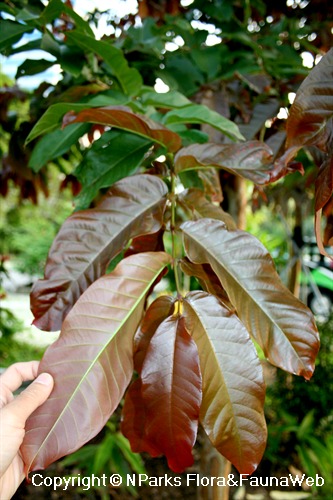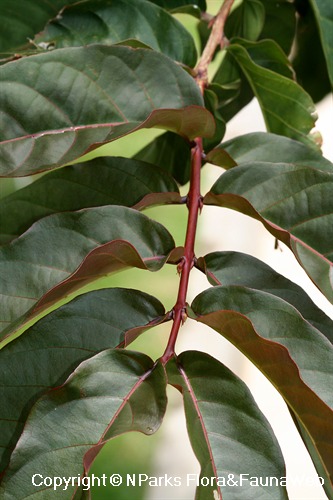
Back
Lagerstroemia floribunda Jack
| Family Name: | Lythraceae |
| Synonyms: | Lagerstroemia turbinata |
| Common Name: | Malayan Crape Myrtle, Thai Crape Myrtle, Tropical Crape Myrtle, Late Crepe-Myrtle, Queen's Flower, Kedah Bungor, Bungur, Antri Gajah |
Name
Classifications and Characteristics
| Plant Division | Angiosperms (Flowering Seed Plants) (Dicotyledon) |
|---|---|
| Plant Growth Form | Tree (Medium (16m-30m), Small (6m-15m)) |
| Lifespan (in Singapore) | Perennial |
| Mode of Nutrition | Autotrophic |
| Plant Shape | Oval |
| Maximum Height | 4 m to 25 m |
Biogeography
| Native Distribution | Indochina (Cambodia, Vietnam, Thailand), Peninsular Malaysia |
|---|---|
| Native Habitat | Terrestrial (Secondary Rainforest, Monsoon Forest) |
| Preferred Climate Zone | Tropical, Sub-Tropical / Monsoonal |
Description and Ethnobotany
| Growth Form | Small to medium-sized tree, with dense bushy, oval to conical-rounded crown, usually 4 - 25 m height. |
|---|---|
| Foliage | Mature leaves dark green and leathery; young leaves coppery-red. Stipules present in leaf axils. Tree is relatively evergreen in wet tropical regions like Singapore, but semi-deciduous in monsoonal areas, where seasonal young foliar flushes are more extensive and pronounced. |
| Flowers | Tree blooms a few times per year, producing erect terminal panicle-inflorescences up to 50cm in height. Individual flowers (3 cm across) have ribbed scruffy-brown calyxes (fused sepals) and flower buds. Velvety crinkled petals fade from rich mauve to pale pink to creamy-white with age, making tree appear to produce flowers of different colours all over the crown. |
| Fruit | Small oblong dehiscent woody capsules borne on branched infructescences, maturing from green to brown, before splitting to disperse abundant small dark brown seeds. |
| Others - Plant Morphology | Bark: Flakes off in plates to reveal greyish-cream-brown patches. |
| Habitat | Open secondary tropical and monsoon riverine gallery forests. |
| Cultivation | Prefers well-drained, humus-rich soils with ample moisture. Extreme drought stress may cause leaf-burn and inhibit blooming. Best to grow at wind-sheltered sunny sites, as shaded moist leaves may be prone to powdery mildew. Propagate by seeds or stem cuttings. Seeds have short viability, so sow as fresh as possible. Rooting hormone can be used to promote the otherwise difficult striking of stem cuttings. |
| Etymology | Genus epithet 'Lagerstroemia' named by Linnaeus (father of modern taxonomy) in honour of his friend Magnus von Lagerstroem (1691-1759), a Swedish merchant (and director of the Swedish East Indies Company), as well as avid naturalist who sent collected specimens of a related species, Lagerstroemia indica to Linnaeus. Species epithet 'floribunda' means 'producing many flowers', a reference to the profuse infloresences. |
| Ethnobotanical Uses | Others: Medicinal: Used to treat fever and myalgia. Regional Myth: Corpse of the last shaman (magician) in Perak, Malaya was disposed of by being placed amongst the branches of a Lagerstroemia floribunda tree between 1870 and 1875, and legend relates that he became a tiger with a white patch. |
Landscaping Features
| Desirable Plant Features | Ornamental Flowers, Ornamental Trunk |
|---|---|
| Landscape Uses | Suitable for Roadsides, General |
| Thematic Landscaping | Naturalistic Garden |
Fauna, Pollination and Dispersal
| Seed or Spore Dispersal | Abiotic (Explosive Dehiscence) |
|---|
Plant Care and Propagation
| Light Preference | Full Sun |
|---|---|
| Water Preference | Moderate Water |
| Plant Growth Rate | Moderate |
| Rootzone Tolerance | Fertile Loamy Soils, Well-Drained Soils |
| Maintenance Requirements | Moderate |
| Diseases | Shaded moist leaves may be affected by powdery mildew. Treat with fungicides or use mildew-resistant varieties. |
| Pest(s) | Associated with |
| Propagation Method | Seed, Stem Cutting |
| Propagule Establishment Remarks | Seeds tend to have short viability. Cuttings strike with difficulty. |
Foliar
| Foliage Retention | Evergreen |
|---|---|
| Mature Foliage Colour(s) | Green |
| Mature Foliage Texture(s) | Smooth, Glossy / Shiny, Leathery, Raised / Sunken Veins, Thick |
| Foliar Type | Simple / Unifoliate |
| Foliar Arrangement Along Stem | Opposite |
| Foliar Shape(s) | Non-Palm Foliage (Elliptical, Oblong) |
| Foliar Venation | Pinnate / Net |
| Foliar Margin | Entire |
| Foliar Apex - Tip | Obtuse |
| Foliar Base | Rounded / Obtuse, Cordate |
| Typical Foliar Area | Mesophyll ( 45cm2 - 182.25 cm2 ) |
| Leaf Area Index (LAI) for Green Plot Ratio | 3.0 (Tree - Intermediate Canopy) |
| Prominent Young Flush Colour(s) Remarks | Red, Coppery-red |
Non - Foliar and Storage
| Trunk Type (Non Palm) | Woody |
|---|---|
| Bark Colour(s) | Grey-cream-brown |
| Mature Bark Texture | Peeling / Flaking / Papery, Smooth |
| Stem Type & Modification | Woody |
| Root Type | Underground (Tap Root, Fibrous Root) |
| Mature Bark Texture Remarks | Smooth bark flakes off in small plates to give mosaic of greyish-cream and brown patches. |
Floral (Angiosperm)
| Flower & Plant Sexuality | Bisexual Flowers |
| Flower Colour(s) | Pink, Purple, White |
|---|---|
| Flower Symmetry | Radial |
| Flower Size - Remarks | 2.5 cm across, 6 petals, borne on terminal panicles 40cm long |
| Inflorescence Type | Panicle |
| Flowering Habit | Polycarpic |
| Inflorescence Size Remarks | Flowers fade from bright mauve to pale pink to white with age. |
| Flowering Period Remarks | Several times per year |
Fruit, Seed and Spore
| Mature Fruit Colour(s) | Brown |
|---|---|
| Fruit Classification | Simple Fruit |
| Fruit Type | Dehiscent Dry Fruit , Capsule |
Image Repository
Others
| Master ID | 1695 |
|---|---|
| Species ID | 2988 |
| Flora Disclaimer | The information in this website has been compiled from reliable sources, such as reference works on medicinal plants. It is not a substitute for medical advice or treatment and NParks does not purport to provide any medical advice. Readers should always consult his/her physician before using or consuming a plant for medicinal purposes. |




























